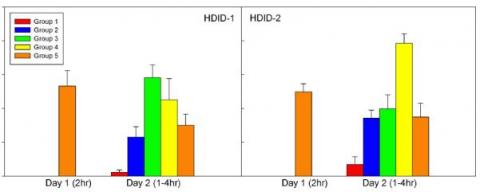
Authors
J. C. Crabbe, P. Metten, J. K. Belknap, S. E. Spence, A. J. Cameron, J. P. Schlumbohm, L. C. Huang, A. M. Barkley-Levenson, M. Ford, and T. J. Phillip
Abstract
Drinking in the Dark (DID) is a limited access ethanol drinking phenotype in mice. High Drinking in the Dark (HDID-1) mice have been bred for 27 selected generations (S27) for elevated blood ethanol concentrations (BECs) after a 4 hr period of access to 20% ethanol. A second replicate line (HDID-2) was started later from the same founder population and is currently in S20. An initial report of response to selection in HDID-1 was published after S11. This paper reports genetic and behavioral characteristics of both lines in comparison with the HS controls. Heritability is low in both replicates (h2 = 0.09) but the lines have shown 4-5 fold increases in BEC since S0; 80% of HDID-1 and 60% of HDID-2 mice reach BECs greater than 1.0 mg/ml. Several hours after a DID test, HDID mice show mild signs of withdrawal. Although not considered during selection, intake of ethanol (g/kg) during the DID test increased by approximately 80% in HDID-1 and 60% in HDID-2. Common genetic influences were more important than environmental influences in determining the similarity between BEC and intake for HDID mice. Analysis of the partitioning of intake showed that 60% of intake is concentrated in the last 2 hr of the 4 hr session. However, this has not changed during selection. Hourly BECs during the DID test reach peak levels after 3 or 4 hr of drinking. HDID mice do not differ from HS mice in their rate of elimination of an acute dose of alcohol.
Reference
Genes Brain Behav. 2014 Feb; 13(2): 236–246. 2013 Dec 6. doi: 10.1111/gbb.12105